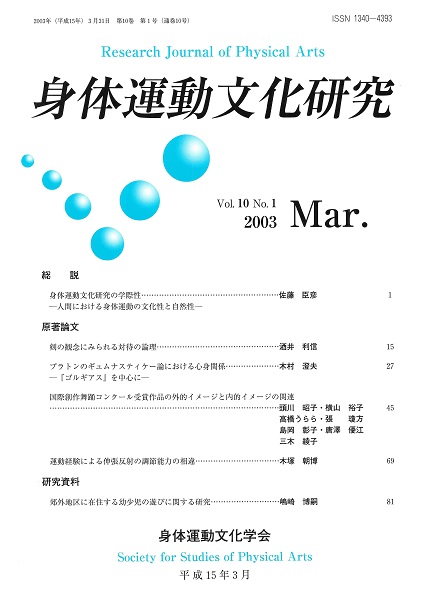The purpose of this study was to clarify characteristics obtained through similarities and differences in images of dance works awarded prizes at an international creative dance contest. The problems were solved through analyzing outer images measured by focusing on words relating to dance movements and inner images measured by focusing on adjective words in semantic space statistically. The results were given a supplementary explanation through using outlines of the matters of dance works on the program and the forms of the works on the VTR, which were evoked images.
Four dance works as prizewinners which were adjudicated by 18 judges and were accepted in "The 10th Saitama International Creative Dance Contest '99" at Saitama in Japan, were selected for this study. In order to measure dance images through a semantic differential method and analyze characteristics of the dance works, 31 scales for outer images and 46 scales for inner images were used. Multivariate statistical analysis procedures were applied to raw data gained from the results which 72 students responded to those scales for each of the dance works.
As the results, the following inferences were derived.
1.Similarities in the dance works
It was found that there were similarities in the four dance works, such as weak impressions in "simple step","transferring by a whole body" and "fluidity" as three dimensions out of 12 in outer images measured, strong impressions in "difficulty" as a dimension out of 8 in inner images measured and devices using various sound materials on the VTR. Especially, it was said in inner images that directions of "difficult feeling" and "beautiful feeling" were imaged commonly in high level's dance works. In addition, there were more similarities in two dance works by Japanese choreographers than those by other countries.
Therefore, it was suggested that similarities in the four dance works were found in outer images and inner images.
2 . Differences in the dance works
It was found that there were the most differences in "balance", "contact with floor" and "costume" as three dimensions out of 12 in outer images measured and in "lucidity" and "spatiality" as two dimensions out of 8 in inner images measured. More over, differences were found in the four dance works such as in titles, themes, compositions of sounds and movements, costumes and tools and sets through analyzing the program and the VTR.
Therefore, it was suggested that differences in the dance works were found in outer images and inner images. In addition to, there were more differences than similarities in the four dance works.
Hence, it is inferred that the characteristics of the dance works accepted at "The 10th International Creative Dance Contest '99" are clarified through analyzing outer images and inner images for dance works.
抄録全体を表示
